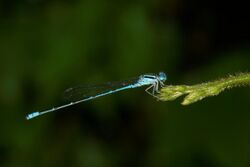Biology:Pseudagrion australasiae
| Pseudagrion australasiae | |
|---|---|

| |
| Male | |
| Scientific classification | |
| Domain: | Eukaryota |
| Kingdom: | Animalia |
| Phylum: | Arthropoda |
| Class: | Insecta |
| Order: | Odonata |
| Suborder: | Zygoptera |
| Family: | Coenagrionidae |
| Genus: | Pseudagrion |
| Species: | P. australasiae
|
| Binomial name | |
| Pseudagrion australasiae Selys, 1876[2]
| |
| Synonyms[4] | |
|
Pseudagrion bengalense Laidlaw, 1919[3] | |
Pseudagrion australasiae is a species of damselfly in the family Coenagrionidae.[5][1] It is found in India , China , Indonesia, Malaysia, Myanmar, Singapore and Thailand.[1]
It is a common damselfly, but usually under-recorded due to its similarity with other blue and black colored Pseudagrion species. Laidlaw described Pseudagrion bengalense as a new species, based on the comparison of his type in the Indian Museum with the mislabeled specimen of P. microcephalum as P. australasiae in British Museum.[3] Lieftinck clarified the situation and placed P. bengalense as a synonym of P. australasiae.[4]
Description and habitat
It is a medium sized damselfly with blue eyes, dark on top. The back of the head is pale blue, bordered with black. Its thorax is azure blue with broad black dorsal and humeral stripes. Abdominal segments 1 and 2 are blue with black marks on the dorsum. A mark on segment 2 looks like a vase, broadly expanded at the middle. Segments 3 to 7 are black on the dorsum and blue on the sides. There are narrow blue apical annules on each segment. Segments 8 and 9 are blue with narrow black apical fringe. Segment 10 has an X-shaped, broad black mark on the dorsum and is blue on the sides. The superior anal appendages are black, diverging outward, and curving inward on the apices like hooks. They are bifid at apices and are half the length of segment 10. The inferiors are as long as the superiors.[6]
It can be distinguished from Pseudagrion microcephalum, Pseudagrion spencei and Pseudagrion malabaricum by its short anal appendages. It can be further distinguished from Pseudagrion malabaricum by its superior anal appendages being bifid at the apices.[6]
The eyes and thorax of the female are bluish green, marked as in the male. The color of the abdomen is similar to the male, but paler. Segments 8 and 9 are also black with fine apical blue rings. Segment 10 is pale blue.[6]
It breeds in ponds, lakes, paddy fields and marshes.[6]
See also
- List of odonates of India
- List of odonata of Kerala
References
- ↑ 1.0 1.1 1.2 Dow, R.A. (2009). "Pseudagrion australasiae". IUCN Red List of Threatened Species 2009: e.T163737A5643795. doi:10.2305/IUCN.UK.2009-2.RLTS.T163737A5643795.en. https://www.iucnredlist.org/species/163737/5643795. Retrieved 20 November 2021.
- ↑ Selys-Longchamps, E. (1876). "Synopsis des Agrionines, (suite de genre Agrion)" (in French). Bulletin de la Classe des Science, Académie Royale de Belgique 42: 506. https://biodiversitylibrary.org/page/34716938.
- ↑ 3.0 3.1 Laidlaw, Frank Fortescue (1919). "A list of the Dragonflies Recorded from the Indian Empire with Special Reference to the Collection of the Indian Museum". Records of the Indian Museum 26: 192–193. http://faunaofindia.nic.in/PDFVolumes/records/016/02/0169-0195.pdf. Retrieved 22 November 2018.
- ↑ 4.0 4.1 Lieftinck, M.A. 1936. On certain types among the Odonata I. Pseudagrion australasiae Selys 1876. Konowia 15(3/4): 167-170.
- ↑ "World Odonata List". University of Puget Sound. https://www.pugetsound.edu/academics/academic-resources/slater-museum/biodiversity-resources/dragonflies/world-odonata-list2/.
- ↑ 6.0 6.1 6.2 6.3 C FC Lt. Fraser (1933). The Fauna of British India, including Ceylon and Burma, Odonata Vol. I. Red Lion Court, Fleet Street, London: Taylor and Francis. pp. 282–284. https://archive.org/details/FraserOdonata1.
Wikidata ☰ Q10641778 entry
 |





